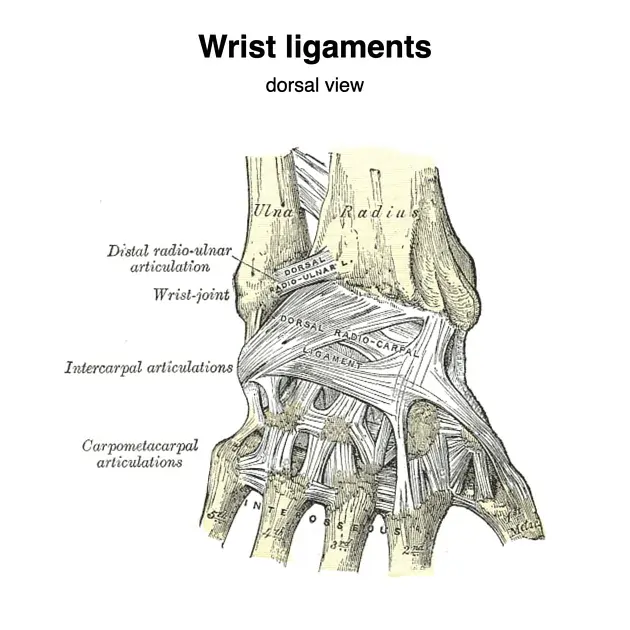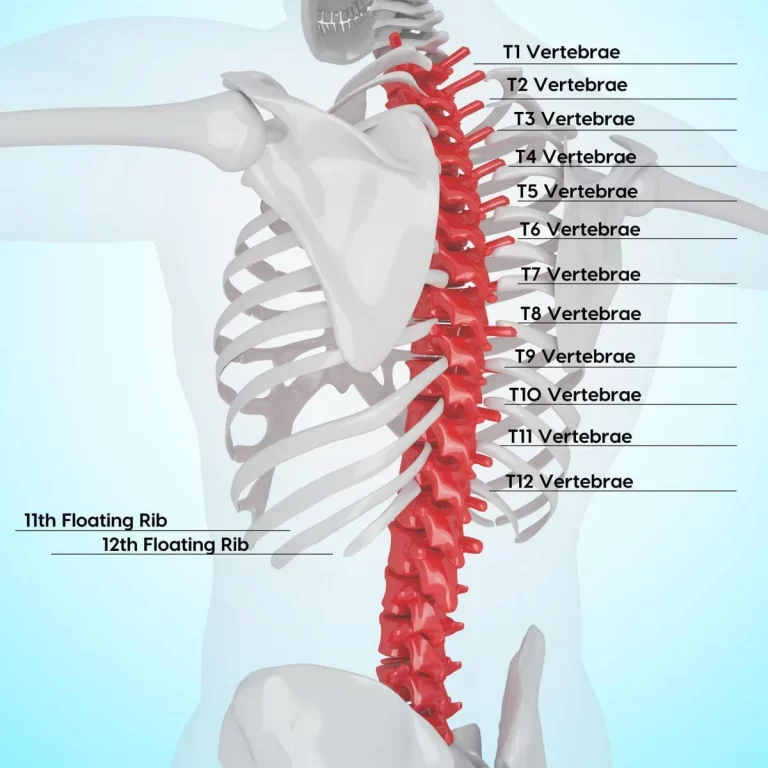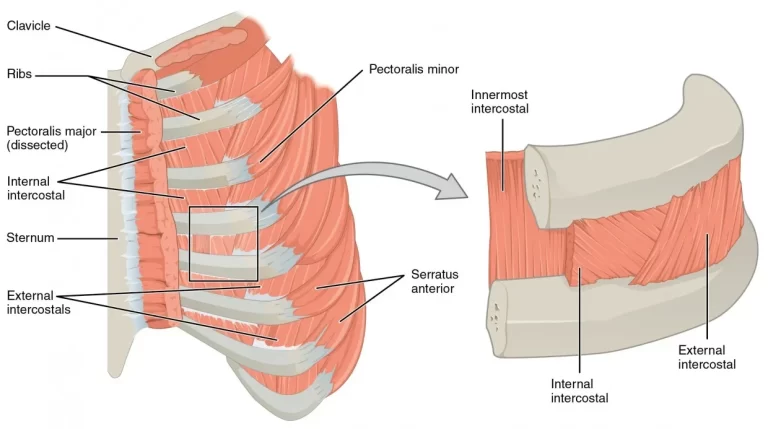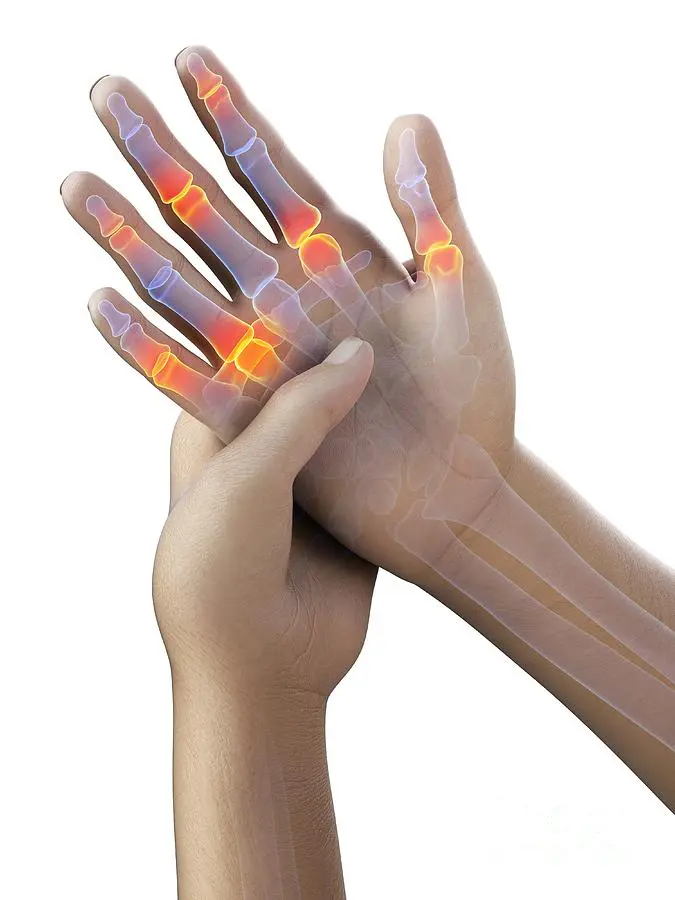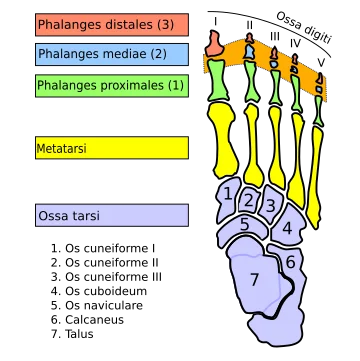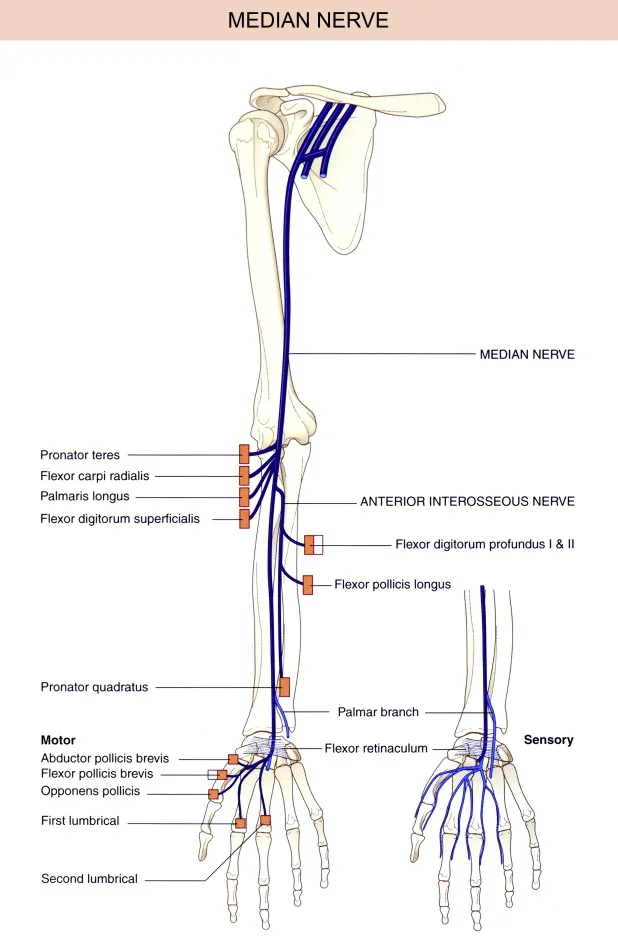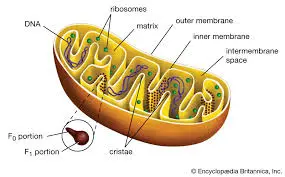Dorsal Radioulnar Ligament
Introduction
The dorsal radioulnar ligament is one of the key stabilizing structures of the distal radioulnar joint (DRUJ), located at the wrist. It connects the distal ends of the radius and ulna on the dorsal (back) side of the forearm. This ligament plays a crucial role in maintaining joint stability during forearm rotation, such as pronation and supination. Injury or laxity in this ligament can lead to pain, instability, or limited motion in the wrist.
The triangular fibrocartilage complex (TFCC), which is situated on the ulnar aspect of the wrist joint between the lunate, triquetrum, and ulnar head, is one of the structures formed by the dorsal radioulnar ligament (DRUL), which is made up of parallel collagen bundles that divide into deep and superficial limbs and attach into the fovea and ulnar styloid. It also covers the radius and ulna.
Pain, swelling, and restricted range of motion are some of the symptoms that can result from injuries to this ligament caused by sudden trauma or repetitive stress.
Depending on the severity of the injury, treatment options for dorsal radiocarpal ligament injuries may include immobilization, physical therapy, surgery, or rest. These injuries can also be avoided with proper technique and strengthening exercises.
Structure of the Dorsal Radioulnar Ligament
A strong band of fibrous tissue called the dorsal radiocarpal ligament connects the proximal row of carpal bones in the wrist joint to the distal end of the radius bone. It is among the main ligaments that support joint stability during motions like wrist flexion and extension.
From the radius bone to the carpal bones, the ligament is composed of multiple fibers arranged in parallel. Tightly packed together, these fibers are attached to the bone by tiny fibers known as Sharpey’s fibers, which give the ligament more strength and stability.
The superficial and deep portions of the dorsal radiocarpal ligament are separated. The superficial part, which is found on the wrist joint’s upper surface, stabilizes the joint when the wrist is extended. The deep portion stabilizes the joint during wrist flexion and is situated beneath the superficial portion.
The dorsal radiocarpal ligament contributes to the transmission of forces between the carpal and radius bones in addition to its primary function of stabilizing the wrist joint. Distributing forces evenly throughout the joint lowers the risk of injury.
The dorsal radiocarpal ligament, which offers stability and support throughout a variety of motions, is an essential part of the wrist joint overall. If you suffer any symptoms of an injury, you should get medical help right away because this ligament can be painful and dangerous.
Functions of the Dorsal Radioulnar Ligament
In the wrist joint, the dorsal radiocarpal ligament serves several vital purposes. These consist of:
- Stabilization: The dorsal radiocarpal ligament’s main function is to keep the wrist joint stable. It keeps the radius bone from moving too far away from the carpal bones and helps hold it in place. This is crucial for wrist flexion and extension movements, which can cause significant joint stress.
- Force transmission: Another factor in the transfer of forces between the radius and carpal bones is the dorsal radiocarpal ligament. This lowers the risk of injury by assisting in the common distribution of forces throughout the joint.
- Joint alignment: The ligament helps in protecting the wrist joint’s correct alignment. This lowers the risk of joint wear and tear by ensuring that the bones glide smoothly against one another during movements.
- Lubrication of the joint: The dorsal radiocarpal ligament contributes to joint lubrication as well. It facilitates the lubrication and reduction of bone-to-bone friction by distributing synovial fluid throughout the joint.
All things considered, the dorsal radiocarpal ligament is an essential part of the wrist joint. In addition to helping to maintain proper alignment and distribute forces evenly throughout the joint, it helps in providing stability and support during a variety of movements. If you suffer any symptoms of an injury, you should get medical help right away because this ligament can be painful and disabled.
Blood supply of the Dorsal Radioulnar Ligament
There are multiple sources of blood flow to the dorsal radiocarpal ligament. The radial artery, which runs along the outside of the wrist, is the primary artery supplying blood to the wrist joint. The dorsal radiocarpal ligament is one of the many branches that the radial artery produces to provide blood to the wrist’s ligaments and other structures.
The ulnar artery, which runs along the inside of the wrist, provides blood to the dorsal radiocarpal ligament in addition to the radial artery. The palmar radiocarpal ligament is one of the many branches that the ulnar artery produces to provide blood to the ligaments and other internal wrist structures.
For the dorsal radiocarpal ligament to remain healthy and function properly, its blood supply is essential. The ligament may weaken or sustain injury in lack of enough blood flow, which could cause wrist joint instability or pain. The blood supply may be affected by ligament injuries, which may increase the ligament’s capacity to heal and recover.
In general, the dorsal radiocarpal ligament’s blood supply plays a significant role in both its health and function. Good blood flow lowers the risk of injury and promotes the best possible joint function by ensuring that the ligament stays stable and strong.
Injuries of the Dorsal Radioulnar Ligament
Several activities that require sudden or repetitive wrist joint movements can cause injury to the dorsal radiocarpal ligament. The following are a few typical activities that may affect this ligament:
Sports: Dorsal radiocarpal ligament injuries are more likely to occur in athletes who play sports like basketball, volleyball, and tennis. The wrist joint must be moved repeatedly in these sports, which can strain the ligament and result in overuse injuries.
Manual labor: Those who work in manual labor occupations, such as mechanics, carpenters, and construction workers, are also more likely to sustain injuries to the dorsal radiocarpal ligament. Overuse injuries may result from the repetitive wrist joint use required for these jobs.
Falls: The dorsal radiocarpal ligament may sprain or tear as a result of a sudden, forceful movement of the wrist joint caused by a fall onto an outstretched hand.
Automobile accidents: The dorsal radiocarpal ligament may sprain or tear as a result of the wrist joint being severely bent or twisted.
Arthritis: Arthritis is a condition that results in joint injury and inflammation. The dorsal radiocarpal ligament may become weaker with arthritis over time, making injuries more likely.
In conclusion, injuries to the dorsal radiocarpal ligament can result from activities that require sudden or repetitive wrist movements, falls, auto accidents, and arthritis. After participating in these activities, it’s critical to get medical help if you suffer from any wrist joint symptoms, such as pain, swelling, or instability.
Symptoms of the Dorsal Radioulnar Ligament Injury
Depending on how severe the injury is, dorsal radiocarpal ligament injuries can present with a variety of symptoms. Typical symptoms include the following:
Pain: An injury to the dorsal radiocarpal ligament most frequently appears as pain. Both the wrist joint and the back of the hand may experience sharp or dull pain.
Swelling: Another typical sign of injury to the dorsal radiocarpal ligament is swelling. It may be difficult to move the wrist joint due to mild or severe swelling.
Stiffness: Another sign of a dorsal radiocarpal ligament injury is stiffness in the wrist joint. It could be difficult to move the wrist joint or carry out daily tasks due to the stiffness.
Instability: One of the most typical signs of a serious dorsal radiocarpal ligament injury is wrist joint instability. It could be difficult to grasp or hold objects because of the instability, which could make the wrist joint feel loose or shaky.
Bruising: In certain situations, injuries to the dorsal radiocarpal ligament may result in bruises around the wrist joint. The bruises may remain for a few days and can be minor or severe.
Numbness or tingling: Numbness or tingling in the fingers or hand may occasionally result from an injury to the dorsal radiocarpal ligament. The nerves that pass through the wrist joint are under pressure, which is the cause of this.
It’s critical to get medical help if you suffer from any of these symptoms following activities that may injure your dorsal radiocarpal ligament. Early intervention may speed the healing process and help stop additional ligament injury.
Diagnosis of the Dorsal Radioulnar Ligament Injury
A robust band of tissue called the dorsal radiocarpal ligament joins the wrist’s carpal bones to the forearm’s radius bone. It is crucial for maintaining wrist joint stability and enabling fluid hand and wrist motion.
Imaging tests, an investigation of medical history, and a physical examination are usually required to diagnose a dorsal radiocarpal ligament injury. A physician will check for pain, swelling, stiffness, and instability in the wrist joint during the physical examination. To assess the wrist joint’s strength and range of motion, they may perform particular tests.
Examining the patient’s medical history involves talking about their symptoms, how the injury happened, and any pertinent past injuries or illnesses.
It may be necessary to imaging tests like CT, MRI, or X-rays to confirm the diagnosis and determine the severity of the injury. Any related injuries, like fractures or dislocations, can also be found with the help of these tests.
Treatment of the Dorsal Radioulnar Ligament Injury
Conservative treatment
Non-surgical techniques are used in the conservative treatment of a dorsal radiocarpal ligament injury to control pain, minimize swelling, and encourage healing. Conservative treatment aims to prevent surgery by letting the ligament heal on its own.
Conservative treatment options for a dorsal radiocarpal ligament injury include the following:
Rest: To promote the healing of the ligament, the wrist joint must be rested. Activities that strain the wrist joint, like heavy lifting or repetitive motions, may be worried for the patient.
Ice: Applying ice to the injured area can help to lessen pain and swelling. Applying ice packs for 15 to 20 minutes at a time, multiple times a day may be recommended for the patient.
Compression: Applying an elastic bandage to the wrist can help to support the joint and lessen swelling.
Elevation: Another way to lessen swelling is to raise the wrist above the level of the heart.
Pain relievers: To control pain and inflammation, over-the-counter medications like ibuprofen or acetaminophen may be suggested.
Physical therapy: To help the wrist joint regain its strength and range of motion, a physical therapist can create an exercise regimen. The exercises might include stretching, strengthening, and range-of-motion exercises.
Immobilization: To immobilize the wrist joint and promote proper ligament healing, the patient may occasionally need to wear a cast or splint.
Following the doctor’s instructions and attending all follow-up appointments are essential to ensuring that the ligament heals correctly. Surgical intervention might be required if conservative treatment fails to bring about relief.
Physiotherapy treatment
The goal of physiotherapy for a dorsal radiocarpal ligament injury is to help the injured ligament heal and return the wrist joint to its normal function. Depending on the patient’s specific needs and the severity of the injury, the treatment plan may change.
Some physiotherapy treatments for a dorsal radiocarpal ligament injury include the following:
Exercises that increase range of motion are used to improve wrist joint flexibility and mobility. The patient may be affected through a variety of exercises by the physiotherapist, including wrist rotations, wrist flexion and extension, and wrist circles.
Strength training: The goal of these exercises is to increase the wrist joint’s supporting muscles’ strength. Exercises like grip strengthening, resistance band exercises, and wrist curls might be suggested by the physiotherapist.
Hands-on methods like massage, joint mobilization, and stretching are used in manual therapy to help reduce pain and increase joint mobility.
Modalities: To lessen pain, swelling, and inflammation, a variety of modalities, including electrical stimulation, ultrasound, heat therapy, and cold therapy, may be used.
Functional training: This involves particular exercises that help the patient regain their functional abilities by simulating their everyday activities.
Education: The physiotherapist might offer instruction on ergonomics, good posture, and ways to avoid getting hurt again.
Exercise regimen at home: To aid in the patient’s recovery outside of physiotherapy sessions, a home exercise regimen may be advised.
Overall, a dorsal radiocarpal ligament injury can be treated with physiotherapy to help with pain management, function restoration, and healing. Attending all appointments and closely following to the physiotherapist’s instructions are crucial for the best possible recovery.
Risk factors
An important structure that joins the wrist’s carpal bones to the forearm’s radius bone is the dorsal radiocarpal ligament (DRL). When moving, it gives the wrist joint support and stability. Several risk factors can result in DRL injuries, including:
Trauma: Wrist trauma, such as a fall or a direct blow to the wrist, is the most frequent cause of DRL injuries. The ligament may stretch or tear as a result of the impact, resulting in wrist joint pain, swelling, and instability.
Sports: Tennis, golf, and gymnastics are among the sports that put athletes at higher risk of DRL injuries because they require repetitive wrist movements. Overuse injuries may result from these activities’ excessive strain on the ligament.
Age: Our ligaments weaken and lose their elasticity as we age, increasing the risk of injury. Due to age-related changes in their ligaments, older adults are more likely to sustain DRL injuries.
Occupational hazards: DRL injuries are more likely to occur in people who perform manual labor or work in occupations that require repetitive wrist movements, like assembly lines or construction workers.
Joint hypermobility: Individuals who suffer from joint hypermobility syndrome are more at risk for ligament injuries due to their loose and unstable joints. Their underlying condition may make them more at risk for DRL injuries.
Genetics: Some individuals may be linked to ligament injuries, including DRL injuries, due to a family history. This could be brought on by genetic connective tissue diseases which decrease ligament elasticity and strength.
In conclusion, several risk factors, such as trauma, sports, age, occupational hazards, joint hypermobility, and genetics, can result in DRL injuries. By being aware of these risk factors, people can avoid or treat DRL injuries by taking precautions and getting medical help when they need it.
How can injuries to the Dorsal Radioulnar Ligament be avoided?
Reducing the risk factors that can result in dorsal radiocarpal ligament injuries is the first step in preventing these injuries. Injuries to the dorsal radiocarpal ligament may be avoided by using the following methods:
Warming up and stretching: It’s crucial to warm up and stretch the muscles and ligaments in the wrist joint before performing any wrist-related activities. This can lower the risk of injury and increase flexibility.
Technique: When performing wrist joint activities, using proper technique and mechanics can help lessen the strain on the ligaments. When typing or lifting, for example, it’s critical to maintain a neutral wrist position and good posture.
Avoid overuse: The risk of injury can be raised by repetitive activities that put too much stress on the wrist joint. It’s critical to take breaks and move in your activities to prevent overuse.
Wear protective gear: Wearing wrist guards or other protective gear can help lower the risk of injury when playing sports or performing other activities that involve impact or falls.
Maintain general health: Maintaining general health via regular exercise, a healthy diet, and enough sleep can help strengthen joints and lower your risk of injury.
Seek medical attention for pain or discomfort: It’s critical to avoid activities that worsen wrist joint pain and discomfort and to get medical help if you’re experiencing it. Ignoring discomfort or pain can result in more problems and injuries.
People may be able to lower their risk of dorsal radiocarpal ligament injuries by using these methods. It’s crucial to speak with a healthcare professional for specific advice on preventing injuries.
FAQs
What is the radiocarpal ligament dorsal?
On the dorsal side of the wrist joint, a robust band of connective tissue called the dorsal radiocarpal ligament joins the wrist’s carpal bones to the forearm’s radius bone.
What function does the dorsal radiocarpal ligament serve?
The wrist joint is stabilized and excessive backward (extension) wrist movement is avoided by the dorsal radiocarpal ligament.
What signs show an injury to the dorsal radiocarpal ligament?
A dorsal radiocarpal ligament injury can cause wrist pain, swelling, stiffness, weakness, and restricted wrist range of motion.
How is an injury to the dorsal radiocarpal ligament diagnosed?
A physical examination, imaging tests like X-rays or MRIs, and potentially an arthroscopy procedure can all be used to diagnose a dorsal radiocarpal ligament injury.
How is a dorsal radiocarpal ligament injury treated?
A dorsal radiocarpal ligament injury can be treated with rest, ice, compression, elevation, physical therapy, immobilization with a cast or splint, and in severe cases, surgery.
How long does it take for an injury to the dorsal radiocarpal ligament to heal?
The severity of the injury and the duration of treatment determine how long it takes for a dorsal radiocarpal ligament injury to heal. A complete recovery could take a few weeks to several months.
Is it possible to avoid a dorsal radiocarpal ligament injury?
Wearing protective gear during high-risk activities, performing wrist-strengthening exercises, and maintaining proper form and technique during repetitive wrist movements can all help prevent a dorsal radiocarpal ligament injury.
References
- Patel, D. (2023d, August 14). Dorsal Radioulnar Ligament – Anatomy, structure, function. Samarpan Physiotherapy Clinic. https://samarpanphysioclinic.com/dorsal-radioulnar-ligament/

